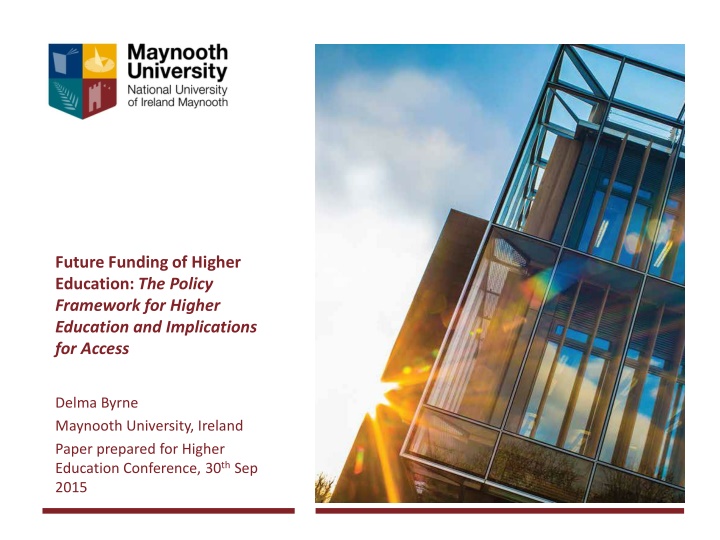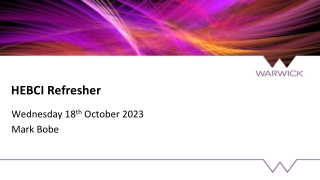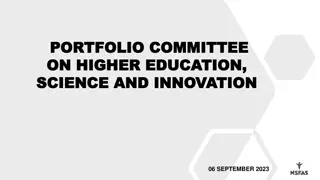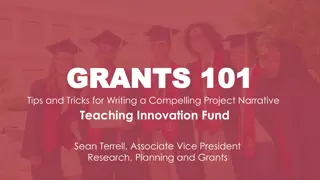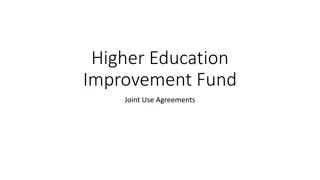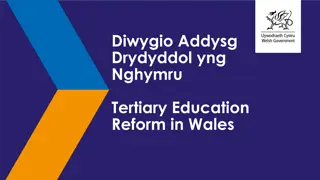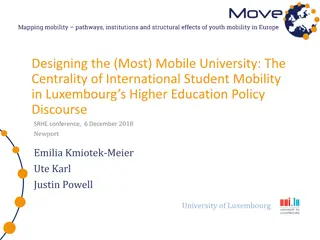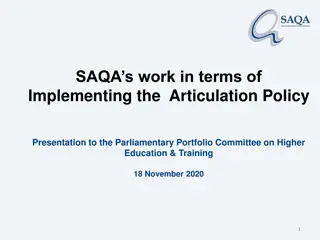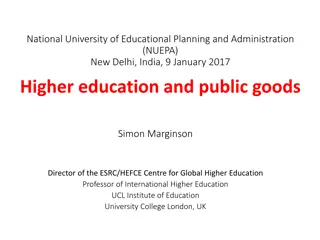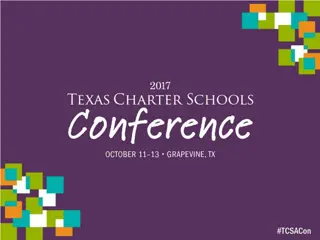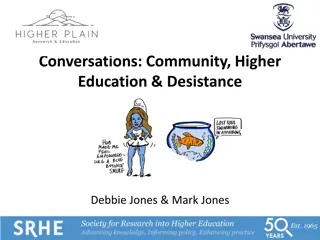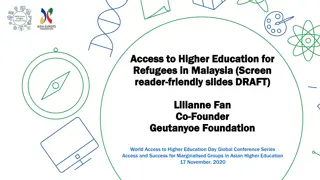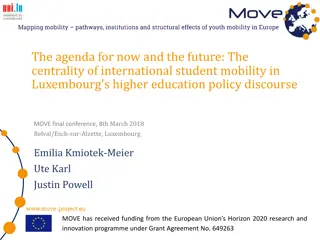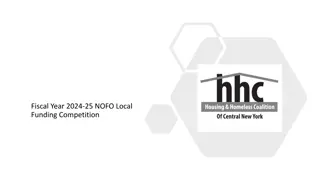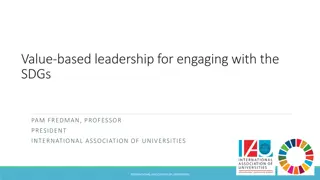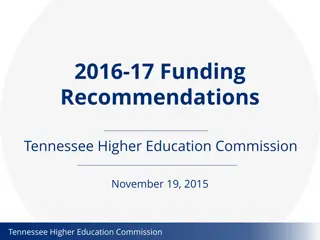Future Funding of Higher Education: Policy Framework and Access Implications
This paper examines the policy framework for higher education funding and its impact on access for underrepresented social groups. It discusses key instruments like entry schemes and grant systems, along with alternative entry routes. The effectiveness of reduced points mechanisms and means-tested grant systems in increasing access is also analyzed.
Download Presentation

Please find below an Image/Link to download the presentation.
The content on the website is provided AS IS for your information and personal use only. It may not be sold, licensed, or shared on other websites without obtaining consent from the author.If you encounter any issues during the download, it is possible that the publisher has removed the file from their server.
You are allowed to download the files provided on this website for personal or commercial use, subject to the condition that they are used lawfully. All files are the property of their respective owners.
The content on the website is provided AS IS for your information and personal use only. It may not be sold, licensed, or shared on other websites without obtaining consent from the author.
E N D
Presentation Transcript
Future Funding of Higher Education: The Policy Framework for Higher Education and Implications for Access Delma Byrne Maynooth University, Ireland Paper prepared for Higher Education Conference, 30thSep 2015
Access Two key policy instruments Entry schemes (HEAR, DARE, Mature Student Route) and reduction in LC points Grant system (financial aid) What measures are necessary to further advance the access to higher education of less represented social groups? (Expert Group, Discussion Paper, Jan 2015)
Alternative Entry Routes to Higher Education Strong and increasing demand for the schemes 88% of mainstream second level schools had submitted applications to HEAR in 2012. 78% of mainstream second level schools had submitted applications to DARE in 2012. Under-representation in accessing the schemes Vocational schools in applications to the HEAR scheme, DEIS schools in applications to the DARE scheme (Byrne et al., 2013) Byrne, D., Doris, A., Sweetman, O., Casey, R., and Raffe, D. 2013. https://www.researchgate.net/publication/281066622_An_Evaluation_of_the_HEAR_and _DARE_Supplementary_Admission_Routes_to_Higher_Education
Alternative Entry Routes to Higher Education Limited effective use of the reduced points mechanism offered by the HEAR and DARE schemes on the part of HEIs. The total number of students accessing higher education via reduced point mechanism has increased between 2010 and 2012, HEAR reduced point applicants accounted for just 44% of HEAR eligible entrants in 2010 and 33% in 2012. DARE reduced point applicants accounted for just 45% of DARE eligible applicants in 2010 and 36% in 2012. (Byrne et al., 2013) Byrne, D., Doris, A., Sweetman, O., Casey, R., and Raffe, D. 2013. https://www.researchgate.net/publication/281066622_An_Evaluation_of_the_HEAR_and _DARE_Supplementary_Admission_Routes_to_Higher_Education
Grant Free Fees introduced in 1995/96 Standard Registration charge to cover costs of examination, provision of student services 190 2011/12 Student Contribution Charge 2,000 2015/16 Student Contribution Charge 3,000
Means Tested Grant System Student support funding, otherwise known as student grants, is made up of two components a maintenance element and a grant to cover the student contribution charge. The level of grant available depends on the means of the student s family. Rates of grant support: Special rate, 100%, 75%, 50% and 25% and of course 0%
Financial barrier to applying to go to college (McCoy, Byrne et al., 2010) 90% and 86% of those from professional and farming backgrounds respectively applied to the CAO in 2004/05, this was true for just approximately 66% of those from other non manual, skilled manual and unskilled manual groups. Non-application was predominately driven by perceptions of HE as being not for me , or alternatively, the pull of working and earning or low academic self- image and low performance expectations, 15% indicated issues relating to lack of affordability McCoy, S., Byrne, D., O Connell, P.J., Kelly, E. and Doherty, C. (2010) Hidden Disadvantage? A Study of the Low Participation in Higher Education by the Non Manual Group, Dublin: Higher Education Authority
Financial barrier to applying to go to college (McCoy, Byrne et al., 2010) Financial concerns surface for all groups, either in the sense of a priority to secure earnings or concern over being able to afford to attend higher education. When it comes to accepting a CAO offer, the intermediate non-manual group and the skilled/unskilled manual groups financial concerns were at the fore, suggesting that this group are more likely to seriously consider HE but fall at the final hurdle owing to financial pressures or ineligibility for state financial support. McCoy, S., Byrne, D., O Connell, P.J., Kelly, E. and Doherty, C. (2010) Hidden Disadvantage? A Study of the Low Participation in Higher Education by the Non Manual Group, Dublin: Higher Education Authority
The Overall Level of Funding of Public HEIs has declined since 2007/08 Expert Group on Future Funding for Higher Education: The Role, Value and Scale of Higher Education in Ireland
Proportion of students requiring HE grant support to pay the increased fee rose from 37% in 2008 to 51% in 2013 Expert Group on Future Funding for Higher Education: The Role, Value and Scale of Higher Education in Ireland
Considerable Legacy IssuesPrior to mid 2000s the grant system had been covering fewer students, and grant levels covering only part of the costs % of full-time students in receipt of a grant fell by nearly a third between 1992 and 2004, a period which saw a growth in participation of students from lower socio-economic backgrounds in Higher Education (McCoy et al., 2009) the higher education maintenance grant had increased only marginally in real (as opposed to nominal) terms between 1973 and 2006 when inflation adjustment is taken into account (see McCoy et al., 2009). Decline in grant receipt was greatest among the non manual group- only group to experience a decline in participation rates.
Reduction in Grant Levels (Special rate and 100% rates) 4000 3500 3420 3420 3420 3250 3120 3110 3025 3025 3025 3020 3000 2500 2000 1500 1370 1370 1370 1300 1250 1245 1215 1215 1215 1210 1000 500 0 2005 2006 2007 2008 2009 2010 2011 2012 2013 2014 Adjacent (<45km) Non-adjacent (>45km)
Costs of Attending HE: Monthly Expenditure (Eurostudent Survey, taken from HEA 2014) Expenditure Item Living with Parents 107 125 110 28 15 3 22 69 55 535 Not Living with Parents 443 202 94 35 19 16 39 72 71 992 All Students 334 177 99 33 18 12 34 71 66 843 Accommodation Food Transportation Communication Health Costs Childcare Debt Payment (except mortgage) Social and Leisure activities Other regular living costs Total
Student Perspectives 39% of students estimated that their family household gross annual income was less than the average industrial wage, approximately 35,000 (Eurostudent survey 2013) The level of financial difficulty increases in line with lower income levels. Overall approximately 18% of students indicated that they are in serious financial difficulty. 25% for students from families whose household family income is between 20,000-35,0000, 36% for students whose household income is less than 20,000 per year. A clear social gradient was also evident between social class and the extent to which students feel they have sufficient funds to cover monthly costs, with students from the manual social classes indicating a higher level of difficulty than those from the non-manual or professional groups.
Purchasing Power the purchasing power or bang for your buck that the grant offers is likely to have declined, as the costs of attending college rise and grant levels fall. Using Eurostudent survey: estimates of the costs of attending college, against means- tested income thresholds for grant receipt
% of college costs that are covered by the grant 120 100 66.3 80 62.6 47.1 49.3 60 33.8 31.4 15.7 26.6 13.6 40 17 12.6 8.5 6.8 6.3 20 3.4 0 Beyond 45km, Living with Parents Beyond 45km, Not Living with Parents Within 45km, Living with Parents Within 45km, Not Living with Parents Special Rate 100% 75% 50% 25% Byrne, D., and Byrne, J.P.
Implication of limited purchasing power At the same time that the purchasing power of financial student support is limited, real family income has eroded for many families living in Ireland. We suggest that a college education may be increasingly out of financial reach for low income families given that the special rate maintenance grant covers just 27% of the costs for those who live within the 45km threshold distance between parental home and college, but who do not live with their parents (and even less for all those at lower maintenance level thresholds). This trend is not unique to Ireland. In the American context, research suggests that the leading needs-based aid programme, the Pell Grant, has diminished substantially over time from covering almost 80% of the costs of going to college in the early 1970s to barely 30% more recently (Goldrick Rab and Kendall 2014) Taken from Byrne and Byrne, working draft in progress Byrne, D. and Byrne, J.P
% of Annual Household Income that needs to be used/borrowed to pay for every year of college 13.8 14 13.4 13.2 13.5 13.05 12.9 13 12.5 11.9 12 11.5 11 10.5 Special Rate 100% 75% 50% 25% Average Byrne, D., and Byrne, J.P.
% of Annual Household Income that needs to be used/borrowed to pay for every year of college 28.9 35 30 19.6 16.3 19.3 14.8 19.2 17.1 25 18.8 17.8 20 13.3 10.7 15 9.8 9.7 9.5 9 8.9 7.6 10 6.2 4.5 5 0 0 Special Rate 100% 75% 50% 25% Within 45km, Not Living with Parents Beyond 45km, Not Living with Parents Within 45km, Living with Parents Beyond 45km, Living with Parents Byrne, D., and Byrne, J.P.
Implications for the experience of being a student Irish and international research indicates that inadequate finances to cover the costs of higher education is likely to impinge substantially on the higher education experience, with the result that there is pressure on students (both with and without a grant) to work part-time and borrow money from family members. This need to work part time affects participation and educational outcomes as the student struggles with the multiple demands on his or her time (Lynch and O Riordan 1998; Darmody and Smyth 2008). As a result, a decreasing proportion of students are gaining the skills and knowledge and experience that the higher education experience can offer. Lynch, K and C. O'Riordan; (1998) Inequality in Higher Education: A Study of Class Barriers. British Journal of Sociology of Education, 19 (4):445-478 Darmody, M., and Smyth (2008) Full-time students? Term-time employment among Higher Education Students in Ireland , Journal of Education and Work, 21(4): 349-362 ,
Student Contribution should not be subsidising capital expenditure needs ! Research in the US indicates that the quality of students experiences on campuses is being compromised by incentives that institutions face to cater to wealthy students. Absent the ability to charge tuition and fees, institutions will be hard pressed to do this. This change may have positive ripple effects for all: studies have found that all students success is enhanced when schools focus on creating community rather than dividing students according to what they can afford, from Goldrick-Rab and Kendall, 2014 Goldrick-Rab, S., and Kendall, N. (2014) Redefining College Affordability: Securing America s Future with a Free Two Year College Option http://www.luminafoundation.org/files/publications/ideas_summit/Redefining_College_ Affordability.pdf
Conclusion 2 key policy instruments that seek to facilitate access are clearly compromised Alternative entry routes Affordability These should be key considerations in any discussion about student contribution
